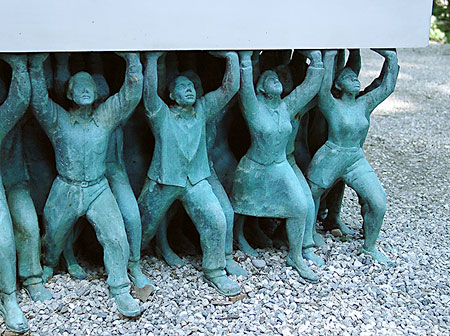Tuesday, midday. My usual method of navigation – turn up vaguely in the area of town I think I remember the Natural History Museum is in, and walk around until I find it – is not working. I know its somewhere near the Plaza de Armas. Having got off at the wrong metro stop, walked for ten minutes in the opposite direction, searched every street on, off and parallel to the Plaza and still not found it, I’m hot, bothered and hungry. Time to take a moment out for lunch.
Of course this becomes a whole new realm of annoyance, as I’m now in a pissy mood and can’t decide on anything. Dithering in front of a fried pollo place, pacing past several spots that seem ‘too touristy’, unable to make up my mind if I should just buy an empenada and eat it on a bench. Hunger makes me stupid, hence me wanting to make what ought to be a refueling situation into a comfort situation – I just wanna sit down somewhere that’s not gonna present a whole language/culture problem for half an hour, to drink a coffee and get my equilibrium back.
After another ten minutes walking in circles I notice what looks like a chain patisserie off one of the side streets of the plaza. The patisserie faces onto the street, selling pastries and bread over a counter, while the building behind appears to be a separate cafe area, a little tucked back from the street but still with a glass front facing a small patio area. There’s a big reassuring photo of a giant croissant on the glass windows, and various signs advertising the usual Santiago-style croissant and coffee deals. My feet hurt, I need coffee, it looks reasonable – I head inside.
And… I stop. I walk in the door, and stop up short, though I’m not exactly sure yet why. There’s… something. Something about the place I’m not sure about… A waitress on the other side of the room looks up, and makes a gesture for me to come in. I hesitate, still not sure. But I’m hungry. And damn it, I’m annoyed at myself for faffing so long already. I sit down at the nearest table.
A few days later, I finally worked out that I had just made a rather embarrassing mistake that, if I admitted it to any Santiagoen, would be considered hilarious. But I didn’t realise that at the time. Only… suspected. In a flustered kind of way.
The place looked like any other cafe. Tiled floor, small round tables with easy to wipe surfaces, bright florescent lighting, aforementioned giant croissant pictures on the wall. But it also looked a little odd. There were only two other customers, even though it was the peak of lunch time – the main meal of the day. Two young guys in black faux-leather jackets and short spiky hair, hunched over coffees, making occasional conversation with long pauses while they stared at the large plasma tv. A bored cashier seated on a tall stool in front of her till: middle-aged, a little plump, but neat enough with her carefully set hair, brown trousers and beige cardigan. The tv itself, blasting out what seemed like an MTV medley – all the hits of the last ten years rattling past in an endless mix that only stopped to give you a verse and chorus of each club anthem before lurching on to the next video. Slightly nauseating after a while, especially as the nearest table when I sat down was the one right underneath it.
But most of all, the waitresses. Two stick thin, very young women in entirely matching outfits and make up. A uniform no doubt. But a uniform of skin tight purple lycra mini-dresses, with spindly black high heels, black patterned tights, long pink nails and electric blue eye shadow. As I sat down a little uncertainly, one of them came over, sweeping long black hair over her shoulder as she handed me a short menu.
She acted exactly like any other waitress would. Which just made me more confused about the frankly weird outfit. I asked for a coffee and sandwich. She told me they only had one sandwich left.
Only one? But – but – what about the giant croissant on the door? Sorry, she says. Only one. But she could have it heated up for me.
I order the one sandwich this cafe has at lunch time, and sit sipping my coffee, trying to work out what is going on. I seem to be the only person here confused. The cashier and the waitresses act like there is nothing at all strange about either their attire, or me being here looking at them in their attire – even though this is a cafe with no food. I start to get paranoid about whether the two guys are really looking at Britney Spears above my head, or at me. Are they laughing at me for being somewhere I shouldn’t be? Because by the time I see a guy walk in off the street and deliver a shopping bag full of sandwiches to the waitress, that he’s obviously just brought from the supermarket over the road, I’m convinced that this must all be a front for something.
The waitress comes back and tells me politely that they now have more sandwiches. Perhaps I’d like to chose a different flavour? She lists the new ones just delivered – tripping back to the tiny little preparation counter on her ridiculously high heels when she forgets one. What she’s saying and how she says it is are utterly ordinary for a waitress. But she does have a tendency to lean in so close towards me that I find myself backing away from her in my chair. Towering above me in her heels with that long black hair about to fall on me as she politely asks if I’d like my chicken and avocado sandwich toasted… I’m grinning like a maniac so she won’t notice that I’m risking a broken neck trying to put another few centimetres between us.
While the sandwich is being taken out of its wrapper and put on a plate, I hunker down over my coffee and notebook, trying to look like I’m really busy and not at all confused. My waitress goes to stand by the cashier, leaning sideways against the counter with her arms over her skinny chest, gazing up at the tv. An air of controlled boredom hovers over them both.
Meanwhile, her matching colleague comes out from the back with a mop and a bottle of pungent bleach cleaner. Still mini-dress clad and stiletto heel shod, she gets down to mopping the floor. The whole floor. Working her way thoroughly round all those empty tables, she pushed on to clean under the table of the two guys who both ignore her as much as she ignores them. The bleach smell is putting me off my cheap white bread and mushy avocado sandwich, which I’m gulping down with as much speed as I can politely muster given that its pretty revolting to start with. She eventually makes her way over to me and, following the lead of the guys, I try to ignore the fact that she’s mopping up under my table while I’m still sitting here. And of course the fact that she’s doing so in what looks like more appropriate clothing for a cheap nightclub than the afternoon shift in a centre of town coffee shop.
I can admire a girl for being able to wash a floor that thoroughly. I can admire her for being able to walk in three inch heels. I can’t help but stare like an idiot at someone who is able to do both at once.
Eventually I have swallowed the last mouthful of my lunch, and the nice purple micro-skirt wearing waitress comes over with my bill. I leave a tip, she wishes me a nice day. As I hurry out, I notice that no one is noticing me, only watching me leave with the bored expressions of employees with no customers and hours to go till they can get out of their uniform and go home. The most confusing part of the whole experience is that I’m the only one who seems to think its really bizarre. Either I just walked into a strip joint posing as a coffee shop (in which case wouldn’t my obvious confusion have at least raised the slightest hint of a condescending eyebrow?), or there’s a really odd fancy dress theme going on today that the staff are totally unfazed by.
Half an hour later, when I finally stopped at an internet place to check, I worked out the Natural History Museum is on the other side of town to the Plaza de Armas. An hour later, when I got there and read the hand painted banner on the door, I found out the museum was closed because the staff were all on strike. Three days later, while looking through my guide book, I came across the following that explained the cafe.

It makes them sound so easy to spot.
The most annoying day I’ve had so far in Santiago? Quite possibly.






